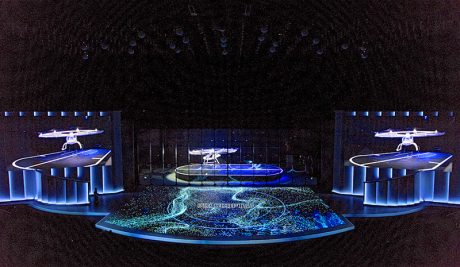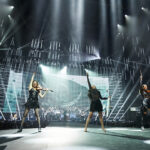WorldStage Partners with JHA on Keynote of Unprecedented Scale and Scope
The Opening Night Keynote at CES 2018 in Las Vegas stood out this year for its dramatic scale and technical scope. Delivered by Intel CEO Brian Krzanich, the presentation on how data is shaping our future enthralled the audience with its vision of futuristic technologies, including next-generation virtual reality and Intel’s Mobileye autonomous car and Mini Shooting Star drones, all enhanced with an array of projection and LED displays. WorldStage and John Halloran Associates (JHA) teamed up to support the visual design of the keynote event, which filled the Park Theater at the Park MGM (formerly the Monte Carlo Resort & Casino) with an eye-catching visual design.

“Since 1991, we’ve partnered with WorldStage on a lot of different events with varying levels of complexity,” says John Halloran, JHA’s executive technical producer. “WorldStage is the company I go to first on these projects, and this one set the mark in terms of scope and size. It was huge and really complicated, but WorldStage broke it down into manageable pieces, and everyone on their team did a great job.”
“There were some huge automated projection elements, and the entire main stage was a giant, immersive LED wall connected to an LED floor,” says James Sarro, general manager at WorldStage West. “The keynote was visually impressive from top to bottom.”
Halloran says the availability of the 5,200-seat Park Theater offered greater flexibility and more opportunities for creativity than past CES keynotes. “We went from the Venetian ballroom with 25-foot-high ceilings, which are very limiting, to 80-foot ceilings in the theater, which allowed for unlimited capabilities, both theatrically and technically.”
Equipment for the show filled nearly four dozen semi-trailers, which loaded into a two-space dock over a 72-hour period. The creative team began designing the keynote back in February 2017. After two weeks of rehearsals in mid-December at the Cow Palace in California, the team loaded 47 53-foot trailers of equipment into Park Theatre starting on Jan. 1, with an 80-percent already-cued show. “We ran twelve hour shifts 24 hours a day, around the clock, until we finished the keynote on Jan. 8 at 8 p.m.,” says Halloran. “It was a very pretty aggressive schedule.”
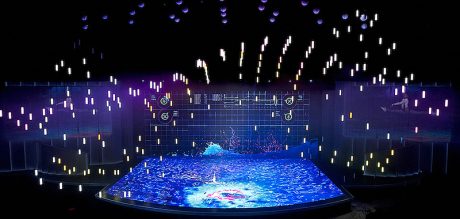
Scoring Technology Firsts
The CES keynote marked a number of technology firsts. “It featured the largest number of disguise (formerly d3) media servers and channels in one place for a single show,” says Sarro. “We really pushed the pixels that went down the pipe for the media servers. The projectors were running full 4K, and a huge number of channels were required to send the signal to the projectors positioned on the balcony rail. And the LED floor and wall were fed with higher than 4K content.”
The keynote also was the first deployment by WorldStage of its i5Floor technology, a 5.2mm interactive LED floor system, which is one of the highest-resolution LED floors available on the rental market. The bottom of the ROE CB5 LED center wall was set in a trough in the stage floor to give the appearance of a seamless, continuous image running from the wall to the floor from any seat in the house. “We wanted the entire stage floor to be LED and to seamlessly wrap to the vertical screen surface,” says Halloran. “And,” he adds, “it had to be engineered to support a car driving over it.”

In addition to the LED displays, WorldStage provided a number of dynamic projection surfaces. A giant six-image-blend VR screen with a huge 9,572-by-1,080 pixel count was lowered up and down to span the stage for extensive demos in the VR segment. A projection-mapped wall of 23 hexagonal columns moved up and down independently or together; they lifted to reveal the Mobileye car driving onstage. Four big Tait Rollios unfurled like scrolls to serve as projection screens, and two large I-Mag screens flanked the stage left and right.
Also on hand were about 200 Nanotubes from Tait, all on individual ceiling winches, plus eight globes and a host of lasers. WorldStage furnished 15 cameras for live feeds, including a broadcast robotic camera for aerial views down onto the stage and a 40-foot jib arm.
All surfaces played back from a complement of 14 disguise media servers — eight 4x4pros and six 2x4pros — for 68 primary channels and 68 back up channels of HD video to cover all the surfaces and generate seven universes of DMX. “It was the largest disguise show ever, in terms of pixels pushed,” says Tj Donoghue, who acted as WorldStage’s integration project manager for the keynote. “We also were able to distribute DMX data to the lasers and to lighting to affect the nanotubes. And we sent timecode drops to audio, lighting, the lasers and automation to synch playback and looks.”
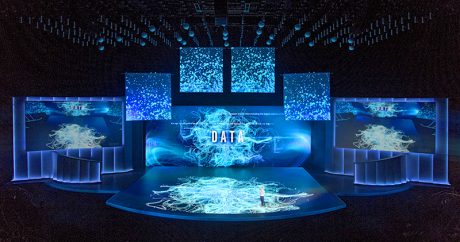
Extensive Preproduction
WorldStage “worked for seven months in conjunction with the scenic designer, video designer and producers in the run up to the show providing them with 3D models and pixel maps,” says Donoghue. “There were nearly 400 axes of automation in the show — everything was tracked: the hex wall, the VR screen, the LED wall, the Rollios. Even the nanotubes flying in and out of the room and the lasers in the show could be colored in various ways. Pixel maps were converted to DMX in disguise, and the DMX data was sent out to the lighting console so the nanotubes could match the video content.”
Prior to the keynote in Las Vegas, WorldStage and JHA staged a two-week mock up at the Cow Palace in San Francisco where they could see all the technical elements at work. They also supported executive rehearsals. “We couldn’t have done it without the Cow Palace rehearsals,” says Halloran. “It guaranteed that we would be successful going into the Park Theater.”
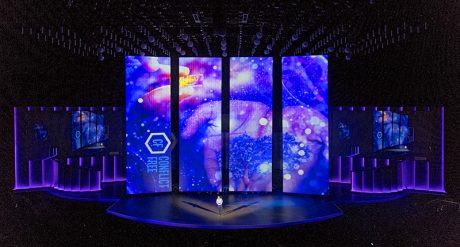
Preproduction was slated for the busy weeks of the Christmas holidays. “Pretty much everyone at WorldStage was part of the development and design teams,” Sarro notes. “Alex Bright, our lead media server programmer, laid out how to put content on everything working closely with the content creators.” Dennis Menard was the senior project manager for WorldStage and John Denion the lead project manager.
The keynote played to “a full house of approximately 4,400 unobstructed seats,” reports Halloran. “That’s almost double the attendance you normally have at the CES keynotes. And thousands more were watching the live stream. Ninety minutes was a long time for people to sit in their seats, but the show was so compelling in its cadence, movement and intriguing visuals that no one left. A lot of industry people were amazed by how beautiful it was. And the client was very, very happy. The team delivered what they asked for on a very high level.”
“It was a super-positive experience — the show was really fun,” adds Donoghue. “A lot of time and energy was expended in making this such a well put-together event. It was a treat to be part of it.”
